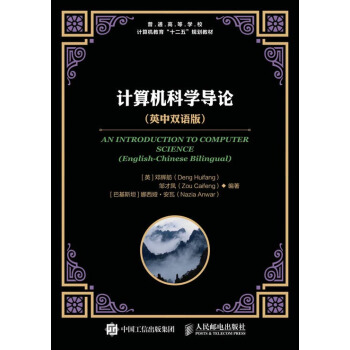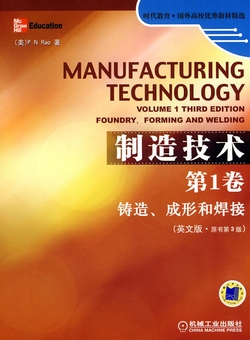计算机科学导论(英中双语版) / 普通高等学校计算机教育十二五规划教材
定价:¥49.80
作者: [英]邓辉舫,邹才凤等
出版时间:2016-09
出版社:人民邮电出版社
- 人民邮电出版社
- 9787115435507
- 1-3
- 69618
- 46212622-8
- 平装
- 16开
- 2016-09
- 455
- 268
- TP3
- 计算机科学
- 本科
作者简介
内容简介
邓辉舫、邹才凤编著的《计算机科学导论》用英汉双语写成,系统而又概要地介绍了计算机学科的定义、范畴、特点以及发展与变化的规律等。本课程的目的不是让学生学习大量具体的专业知识,而是针对所有对计算机感兴趣的学生进行入门性导引。全书由16章组成,分为6大部分:绪论,数据表示与操作,计算机硬件,计算机软件,数据组织与抽象以及高级与前沿专题(例如,物联网、云计算、大数据等),涵盖了计算机科学各个领域(包括最新领域)的最新进展、所有经典与丰富的前沿主题,以及跨学科、跨行业的应用。可以拓展读者的知识视野,能够帮助他们较全面地了解计算机科学的学科特点与发展现状,为今后深入学习计算机科学的各门专业课程打下基础。本书每一章末尾都包含本章小结,附有参考读物及一定量的练习,以帮助学生巩固己学的知识和课后进行深入的探讨。
本书既适合国内高等院校各专业用作计算机基础课教材,也可以供希望了解计算机相关领域知识的非专业读者作为入门参考。
本书既适合国内高等院校各专业用作计算机基础课教材,也可以供希望了解计算机相关领域知识的非专业读者作为入门参考。
目录
Unit 1 Introduction
l.l What Is Computer Science?
1.2 Von Neumann Model
1.3 Computer Components
1.4 History and Development Trends
1.5 Frontiers of Computer Technology
1.6 Major Fields of Computer Science
1.7 References and Recommended Readings
1.8 Summary
1.9 Practice Set
Unit 2 Number Systems and
Conversions
2.1 Introduction
2.2 Positional Number Systems
2.3 Non-Positional Number Systems
2.4 References and Recommended
Readings
2.5 Summary
2.6 Practice Set
Unit 3 Data Storage and
Compression
3.] Bit Pattern
3.2 Integer in Computer
3.3 Floating-Point in Computer
3.4 Data Storage
3.5 Cloud Storage and Big Data Storage
3.6 References and Recommended Readings
3.7 Summary
3.8 Practice Set
Unit 4 Data Operations
4.1 Logical Operations
4.2 Arithmetic Operations
4.3 Shift Operations
4.4 References and Recommended Readings
4.5 Summary
4.6 Practice Set
Unit 5 Computer Components
5.1 Three Main Components
5.2 Components Interconnection
5.3 Machine Cycle
5.4 Computer Architectures
5.5 References and Recommended Readings
5.6 Summary
5.7 Practice Set
Unit 6 Computer Networks
6.1 Types of Networks
6.2 TCP/IP Model
6.3 Devices in Networks
6.4 New Development in Networks
6.5 References and Recommended
Readings
6.6 Summary
6.7 Practice Set
Unit 7 Operating Systems
7.1 Categories
7.2 Components
7.3 Popular Operating Systems
7.4 References and Recommended
Readings
7.5 Summary
7.6 Practice Set
Unit 8 Algorithm
8.1 What Is Algorithm?
8.2 Three Constructs
8.3 How to Evaluate Algorithms
8.4 Algorithm Representation
8.5 Basic Algorithms
8.6 Classification of Algorithm
8.7 References and Recommended
Readings
8.8 Summary
8.9 Practice Set
Unit 9 Programming
Languages
9.1 Development
9.2 Program Translation
9.3 Languages' Latest Ranking, Categories
and Features
9.4 Common Concepts of Programming
Languages
9.5 Severe Software Errors
9.6 References and Recommended
Readings
9.7 Summary
9.8 Practice Set
Unit 10 Software Engineering
10.1 Introduction
10.2 Software Development Life Cycle
10.3 Software Development Models
10.4 CMMI and Software Process
Management
10.5 Importance of Documentation
10.6 Service-Oriented Architecture
10.7 References and Recommended
Readings
10.8 Summary
10.9 Practice Set
Unit 11 Data and File Structures
11.1 Abstract Data Types
11.2 List
11.3 Stack
11.4 Queue
11.5 Tree and Graph
11.6 File Structure
11.7 References and Recommended
Readings
11.8 Summary
11.9 Practice Set
Unit 5 2 Databases
12.1 Introduction
12.2 Database Management Systems
12.3 Database Architecture
12.4 The History of Database Systems
12.5 Database Model
12.6 Relational Operations
12.7 Databases for Big Data
12.8 References and Recommended
Readings
12.9 Summary
12.10 Practice Set
Unit 13 Security
13.1 Security Goals
i3.2 Security Threats
13.3 Security Services
13.4 Cryptography
13.5 References and Recommended
Readings
13.6 Summary
13.7 Practice Set
Unit 14 Theory of Computation
14.1 The Turing Machine
14.2 Halting Problem
14.3 Solvable Problems
14.4 References and Recommended
Readings
14.5 Summary
14.6 Practice Set
Unit 15 Artificial Intelligence
15.1 Introduction
15.2 Knowledge Representation and Expert
Systems
15.3 Perception
15.4 Reasoning
15.5 Nature Inspired Computation
15.6 References and Recommended
Readings
15.7 Summary
15.8 Practice Set
Unit 16 Internet of Things, Cloud
Computing and Data
Science
16.1 Introduction
16.2 Opportunities in IoT, Cloud, and Data
Science
16.3 Challenges and Research Directions
16.4 IoT Applications
16.5 Cloud Application Service Models
16.6 Cloud Application Deployment
Models
16.7 Big Data Tools and Techniques
16.8 Integration ofloT, Cloud Computing, and
Big Data
16.9 References and Recommended
Readings
16.10 Summary
16.11 Practice Set
l.l What Is Computer Science?
1.2 Von Neumann Model
1.3 Computer Components
1.4 History and Development Trends
1.5 Frontiers of Computer Technology
1.6 Major Fields of Computer Science
1.7 References and Recommended Readings
1.8 Summary
1.9 Practice Set
Unit 2 Number Systems and
Conversions
2.1 Introduction
2.2 Positional Number Systems
2.3 Non-Positional Number Systems
2.4 References and Recommended
Readings
2.5 Summary
2.6 Practice Set
Unit 3 Data Storage and
Compression
3.] Bit Pattern
3.2 Integer in Computer
3.3 Floating-Point in Computer
3.4 Data Storage
3.5 Cloud Storage and Big Data Storage
3.6 References and Recommended Readings
3.7 Summary
3.8 Practice Set
Unit 4 Data Operations
4.1 Logical Operations
4.2 Arithmetic Operations
4.3 Shift Operations
4.4 References and Recommended Readings
4.5 Summary
4.6 Practice Set
Unit 5 Computer Components
5.1 Three Main Components
5.2 Components Interconnection
5.3 Machine Cycle
5.4 Computer Architectures
5.5 References and Recommended Readings
5.6 Summary
5.7 Practice Set
Unit 6 Computer Networks
6.1 Types of Networks
6.2 TCP/IP Model
6.3 Devices in Networks
6.4 New Development in Networks
6.5 References and Recommended
Readings
6.6 Summary
6.7 Practice Set
Unit 7 Operating Systems
7.1 Categories
7.2 Components
7.3 Popular Operating Systems
7.4 References and Recommended
Readings
7.5 Summary
7.6 Practice Set
Unit 8 Algorithm
8.1 What Is Algorithm?
8.2 Three Constructs
8.3 How to Evaluate Algorithms
8.4 Algorithm Representation
8.5 Basic Algorithms
8.6 Classification of Algorithm
8.7 References and Recommended
Readings
8.8 Summary
8.9 Practice Set
Unit 9 Programming
Languages
9.1 Development
9.2 Program Translation
9.3 Languages' Latest Ranking, Categories
and Features
9.4 Common Concepts of Programming
Languages
9.5 Severe Software Errors
9.6 References and Recommended
Readings
9.7 Summary
9.8 Practice Set
Unit 10 Software Engineering
10.1 Introduction
10.2 Software Development Life Cycle
10.3 Software Development Models
10.4 CMMI and Software Process
Management
10.5 Importance of Documentation
10.6 Service-Oriented Architecture
10.7 References and Recommended
Readings
10.8 Summary
10.9 Practice Set
Unit 11 Data and File Structures
11.1 Abstract Data Types
11.2 List
11.3 Stack
11.4 Queue
11.5 Tree and Graph
11.6 File Structure
11.7 References and Recommended
Readings
11.8 Summary
11.9 Practice Set
Unit 5 2 Databases
12.1 Introduction
12.2 Database Management Systems
12.3 Database Architecture
12.4 The History of Database Systems
12.5 Database Model
12.6 Relational Operations
12.7 Databases for Big Data
12.8 References and Recommended
Readings
12.9 Summary
12.10 Practice Set
Unit 13 Security
13.1 Security Goals
i3.2 Security Threats
13.3 Security Services
13.4 Cryptography
13.5 References and Recommended
Readings
13.6 Summary
13.7 Practice Set
Unit 14 Theory of Computation
14.1 The Turing Machine
14.2 Halting Problem
14.3 Solvable Problems
14.4 References and Recommended
Readings
14.5 Summary
14.6 Practice Set
Unit 15 Artificial Intelligence
15.1 Introduction
15.2 Knowledge Representation and Expert
Systems
15.3 Perception
15.4 Reasoning
15.5 Nature Inspired Computation
15.6 References and Recommended
Readings
15.7 Summary
15.8 Practice Set
Unit 16 Internet of Things, Cloud
Computing and Data
Science
16.1 Introduction
16.2 Opportunities in IoT, Cloud, and Data
Science
16.3 Challenges and Research Directions
16.4 IoT Applications
16.5 Cloud Application Service Models
16.6 Cloud Application Deployment
Models
16.7 Big Data Tools and Techniques
16.8 Integration ofloT, Cloud Computing, and
Big Data
16.9 References and Recommended
Readings
16.10 Summary
16.11 Practice Set




